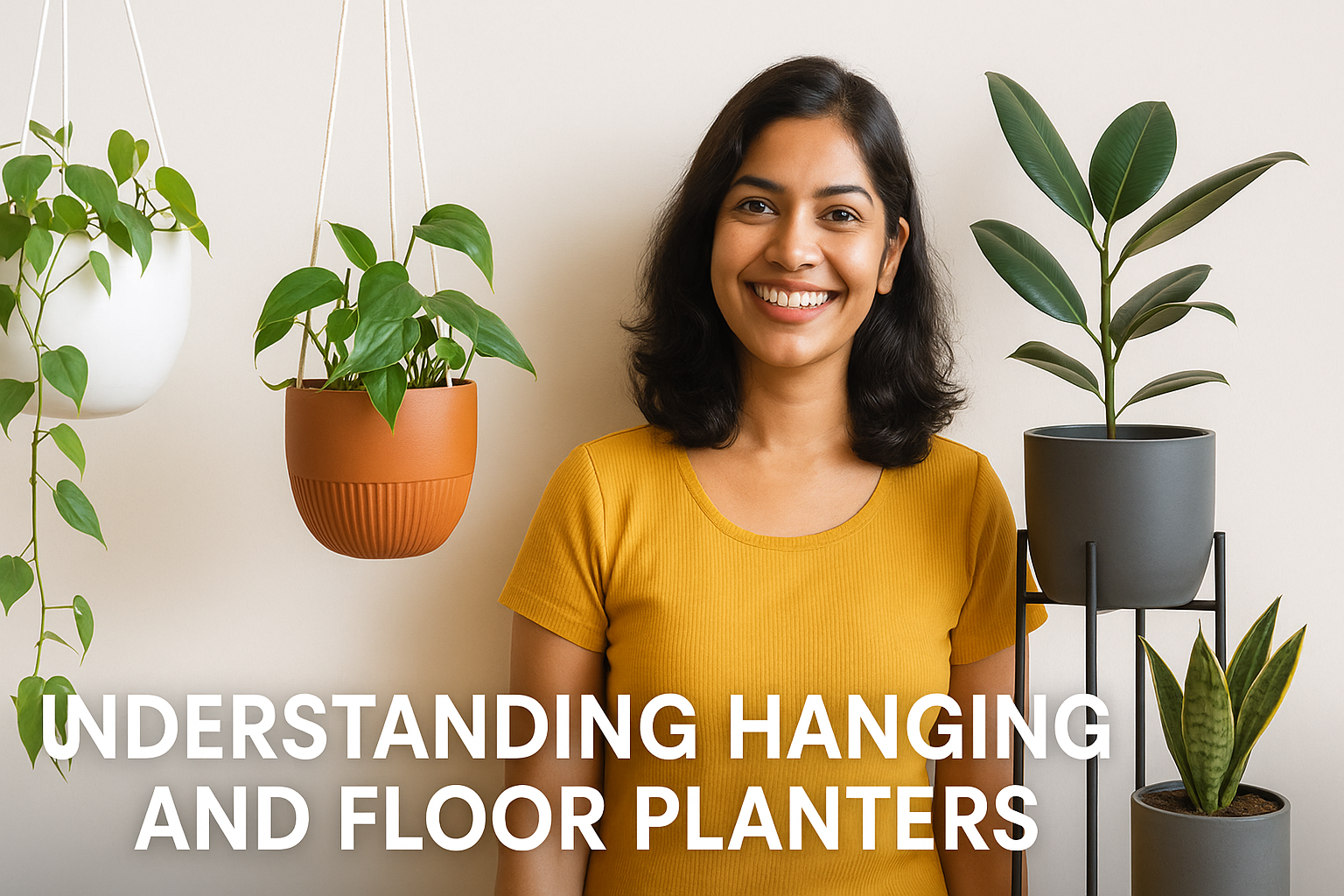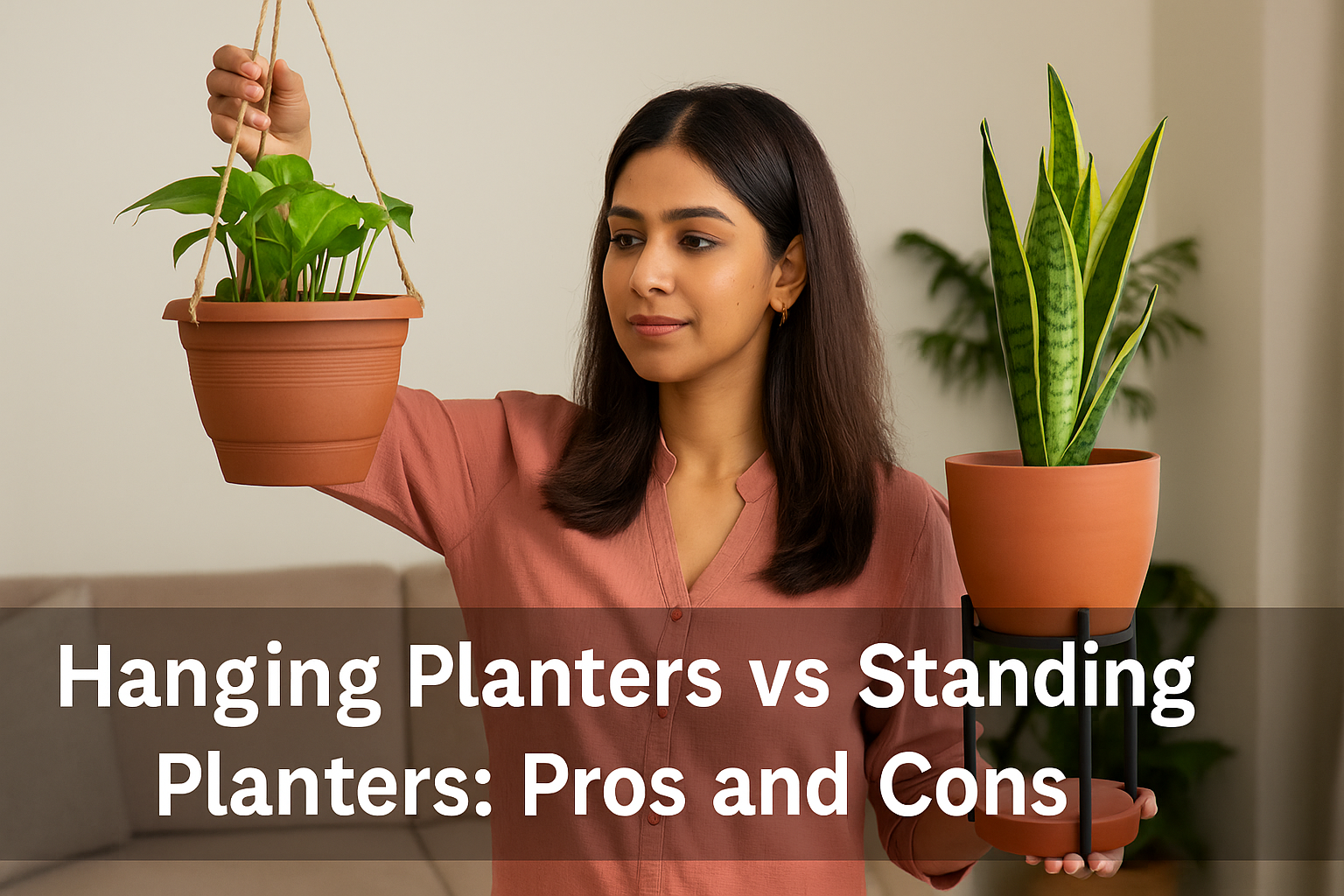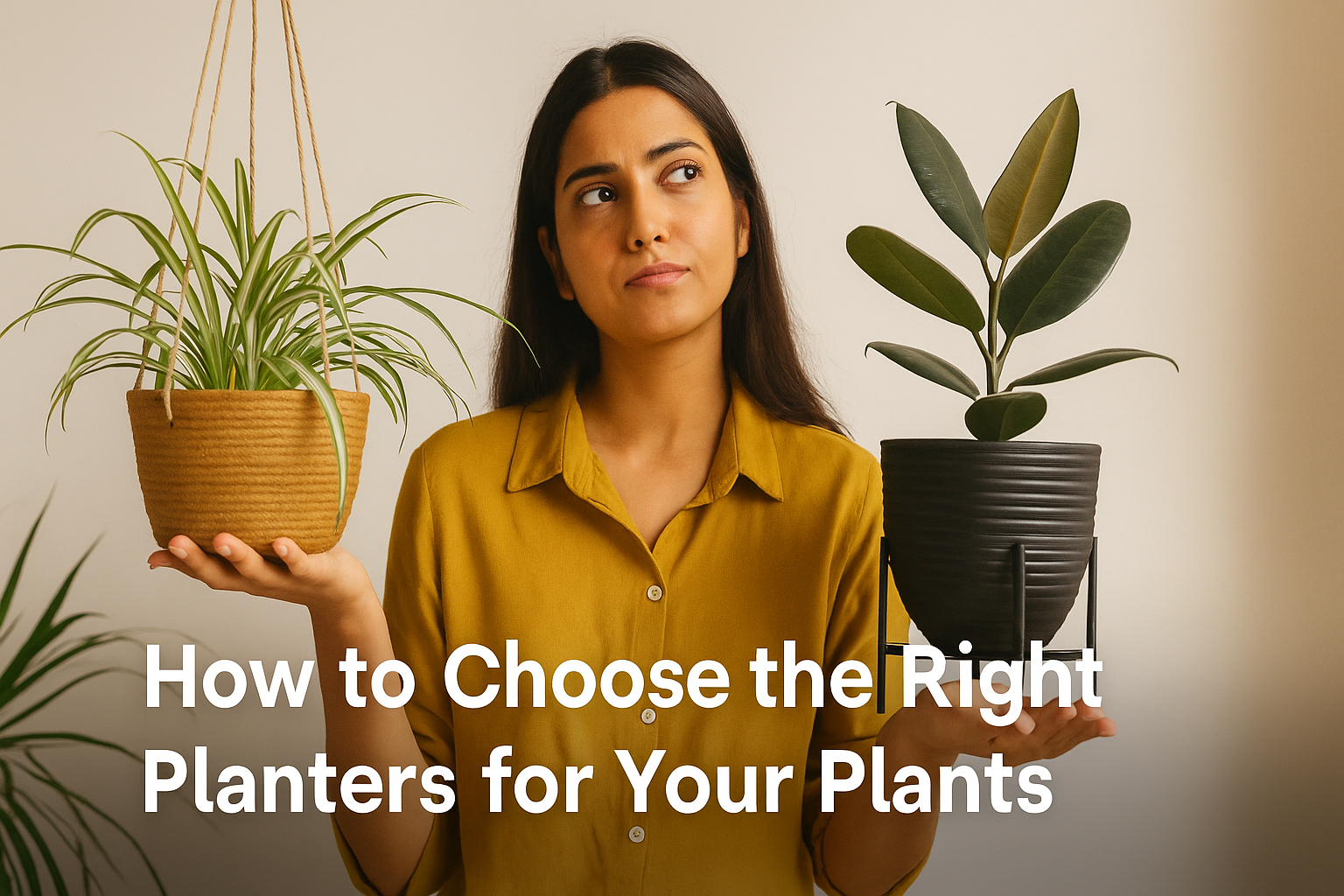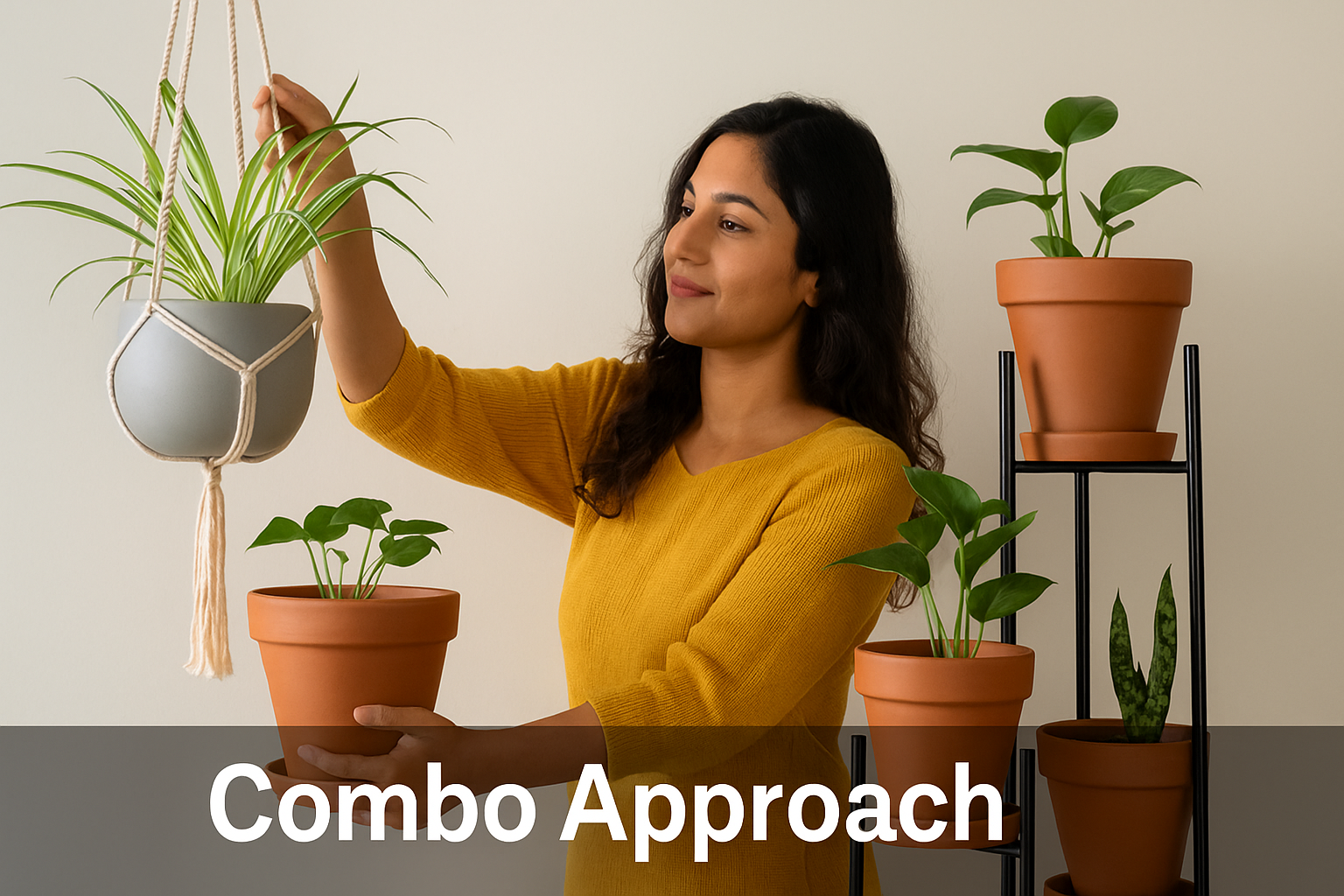.jpg)
Home gardening enthusiasts often face a common dilemma: hanging planters vs floor planters – which is better for your space?
Both hanging and standing planters can elevate your indoor garden game.
The best flower pot for your home depends on your decor, available space, and plant needs.
In this guide, we’ll compare hanging vs standing planters in detail, answer your burning questions, and help you choose the right planters for your plants.
By the end, you’ll know whether a dangling hanging pot or a grounded floor planter (or a mix of both) is the perfect fit for your green oasis.
Understanding Hanging and Floor Planters

Hanging planters (or hanging pots) are containers suspended from ceilings, walls, or railings using hooks, ropes, or macramé hangers.
They literally hang in the air, allowing plants to cascade down.
This makes use of vertical space – a huge bonus if you have limited room.
Urban gardeners love hanging planters because they maximize space and even help create DIY vertical gardens.
In contrast: floor planters (also called standing planters) are pots or containers that sit on the ground or on a stand.
These include large pots placed directly on the floor and planters on elevated stands or holders.
A planter stand indoor is a decorative rack or floor pot stand that holds your pot a few inches (or feet) off the ground.
Floor planters are ideal for bigger, bushy plants or trees that need steady support.
At a glance: Hanging planters save floor space and add greenery at eye-level or above, while floor planters provide sturdy homes for larger plants and can be moved around.
Many home gardeners actually use both to create layers of greenery.
Let’s break down the pros and cons of each type to help you decide the best flower pot for your home.
Read More Gardening Insperation
Top 13 Low-Maintenance Indoor Plants For Busy People
How To Protect Yourself While Gardening With Gloves: Ultimate Safety Guide
Hanging Planters vs Standing Planters: Pros and Cons In-Depth Comparison

| Aspect | Hanging Planters (Hanging Pots) | Floor Planters (Standing Planters / Floor Pot Stand) |
|---|---|---|
| Ideal Space | Small rooms, balconies, bathrooms, limited floor space | Spacious rooms, corners, hallways, patios |
| Design Advantage | Adds vertical interest, perfect for layered or boho-style decor | Grounds décor, creates a focal point in corners or entryways |
| Plant Suitability | Trailing/vining plants like pothos, ivy, ferns | Upright/bushy plants like rubber plant, palms, fig trees |
| Weight Capacity | Limited – for small, lightweight pots | High – can support heavy pots and tall plants |
| Installation | Requires ceiling/wall hooks or railings | None – ready to place on floor or stands |
| Mobility | Fixed after installation; harder to relocate | Easy to move or rotate based on sunlight |
| Watering | May drip water; sometimes difficult to reach | Simple to water with tray or saucer underneath |
| Child/Pet Safety | Safe – plants out of reach | Moderate – risk of tipping if knocked |
| Air Circulation | Excellent – better airflow around plant | Moderate – depends on room ventilation |
| Visual Appeal | Creates eye-level greenery and softens vertical spaces | Grounds decor and adds bold focal points |
| Maintenance Level | Medium – harder to prune or replant | Low – easy to maintain and water |
As you can see, hanging vs floor planters isn’t about one being better universally – it’s about what fits your situation.
Hanging planters shine in vertical gardening and tight spaces, while floor planters are the go-to for larger plants and flexible decorating.
How to Choose the Right Planters for Your Plants

When deciding between hanging or standing planters (or deciding on a specific pot in general), consider these factors to choose the right planters for your plants:
- Plant Type & Growth Habit: Think about how your plant naturally grows. Does it trail or vine? If yes, a hanging planter lets it cascade freely (English ivy, pothos, spider plants are great in hanging pots). If the plant grows upright or large (like rubber plants, snake plants, or monstera), a floor planter or pot on a planter stand is more suitable for support. For bushy or heavy plants, floor planters are usually the right choice to handle the weight.
- Available Space: Survey your home. In a small apartment or studio, you may not have much floor area – so utilize vertical space with hanging planters or wall-mounted pots. Conversely, if you have spacious corners or an empty floor spot that could use some life, a decorative floor planter is perfect.
- Light and Location: Where will the planter go? Hanging planters near windows can give plants more light (they’re up near the window). Floor planters can be moved around to catch sunbeams across the room. However, hanging ones are harder to relocate once installed.
- Weight & Support: Be realistic about weight. A ceramic pot filled with soil and a mature plant can be very heavy. If you want to hang a heavy planter, use strong hooks anchored into studs, or opt for lighter materials (plastic, fiberglass) and smaller sizes. Otherwise, it’s safer to keep it on the floor.
- Watering and Drainage: If you’re the type to possibly overwater, know that hanging planters will drip. Look for hanging pots with built-in drip trays, or use liners. You may need to take the plant down to water it thoroughly and let it drain in the sink. Floor planters generally can have a saucer underneath to catch excess water. Self-watering planters are available in both hanging and floor styles if you want lower maintenance.
- Aesthetic and Decor: Ultimately, consider your personal style (we’ll dive into design next). The planter is as much a decor piece as it is a home for your plant. If you love bohemian decor, a jute macramé hanging planter will complement it.
By evaluating these aspects, you can choose the best planter for each of your plants. For example, you might decide to hang a trailing pothos in a corner near the ceiling, place a tall palm in a floor planter by the entrance, and line your balcony railing with a few hanging pots for herbs.
Indoor Planter Design Considerations

Choosing planters isn’t just about the plants – it’s also about your interior design.
Here are some design considerations to keep your indoor garden cohesive and beautiful:
- Visual Balance: If all your plants are on the floor, the eye is drawn only to one level. Mixing hanging and floor planters adds depth. For instance, hang a couple of plants at varying heights in one corner and place a shorter floor plant below. This creates a “green cascade” effect filling the vertical space.
- Style and Material: Match planters to your decor theme. For a modern living room, sleek metal or ceramic planters on stands can act like art pieces. For a cozy rustic vibe, use woven hanging baskets or terracotta floor pots. You can even find eco-friendly recycled planters that look chic and align with sustainable values.
- Color Coordination: Your planters don’t all have to be the same color, but a consistent palette helps. Neutral tones (white, black, gray, earth tones) are safe and let the plant be the star. You can add a pop of color with one or two statement planters. Hanging planters often come in fun colors – you might use those as accent pieces.
- Planter Stands as Furniture: Think of indoor planter stands as pieces of furniture or art. A wrought iron stand or a mid-century wooden plant holder elevates not just the plant, but the style of the whole room. When choosing a stand, look at its finish (matte black, glossy gold, natural wood, etc.) and design (geometric, ornate, minimalist).
- Placement and Spacing: Be mindful of traffic flow in the room. Floor planters should be placed where they won’t be constantly bumped. Corner areas, either side of a sofa, or beside a console table are popular spots. Hanging planters should hang where people won’t walk into them (nobody enjoys a spider plant brushing their hair unexpectedly!).
- Lighting as Décor: You can incorporate lighting with planters too. For example, some hanging planters come with fairy lights woven in, or you can direct a spotlight to highlight a beautiful floor planter.
Remember, indoor planter design is also about your personal expression. Don’t be afraid to experiment.
You might dedicate one corner of your living room as the “green corner” with a cluster of floor pots on a floor pot stand and a couple of hanging plants above.
In another room, a single dramatic hanging planter with a bold plant could serve as living art on an empty wall.
Browse inspirations and product pages (like Urban Plant’s hanging planters or planter stands) to see how different designs can be used.
Combining Hanging and Floor Planters for the Best of Both

After comparing hanging vs floor planters, you might realize the best solution is a mix.
Most homes benefit from a combination – use hanging planters where you can to save space or add a wow factor, and use floor planters for larger or more grounded displays.
For example, you could hang a string of pearls plant near a sunny kitchen window and place a pot of aloe vera on the counter below.
There’s no strict rule that you must choose one over the other. It’s all about finding the best flower pot arrangement for your home.
In fact, many successful indoor gardens use tiered displays: tall plants on the floor, medium plants on stools or shelves, and small trailing plants hanging above.
Also consider seasonality and growth. You might start a plant on a shelf or floor, and as it grows long vines, transition it into a hanging basket to let it shine.
Swapping planters is part of the fun of home gardening and decorating.
Finally, keep practicality in mind. Even if you adore hanging planters, you don’t want to overdo them and end up with a ceiling full of pots that are hard to maintain.
Similarly, too many floor planters can clutter the walking areas. Strive for balance.
Bonus Tip: Reevaluate over time. As plants grow, their needs or weight may change. Don’t hesitate to repot a hanging plant into a floor pot if it becomes too heavy, or elevate a floor plant onto a hanging shelf if it stays small. The “best pot” for your plant today might change next year – and that’s okay!
FAQ
Q1. What’s the difference between hanging planters and floor planters?
A: Hanging planters are suspended from ceilings or walls, ideal for small spaces and trailing plants. Floor planters rest on the ground or stands and are perfect for larger or upright plants.
Q2. Which is the best flower pot for your home—hanging or floor?
A: The best flower pot depends on your space and plant type. Use hanging pots to save space and floor pots for larger plants or statement decor.
Q3. Are hanging pots safe for indoor use?
A: Yes, as long as they're securely installed using ceiling hooks or brackets, hanging pots are safe and also keep plants out of reach from kids and pets.
Q4. How do I choose the right planter for my plants?
A: Choose based on the plant's size, weight, growth pattern, and location. For trailing plants and tight spaces, go with hanging planters; for bigger, upright plants, use a planter stand indoor.
Q5. Can I use both hanging and floor planters together?
A: Absolutely! Mixing hanging and floor planters creates a balanced, layered look and helps utilize both vertical and horizontal space efficiently.
Final Verdict: Choosing the Best Flower Pot for Your Home
Ultimately, the best choice depends on your space, plant types, and aesthetic preferences.
Hanging planters are used to maximize vertical spaces, and floor planters are used for larger plants and statement decor.
A thoughtful combination of both types creates a balanced, appealing green haven.
NASA (Spinoff Report) – Indoor plants removed significant amounts of pollutants and eased “sick building” symptoms in a sealed test home





